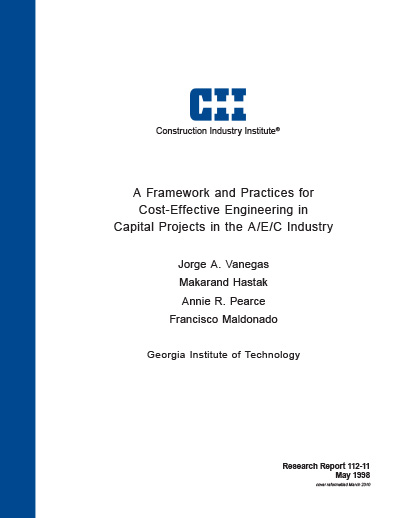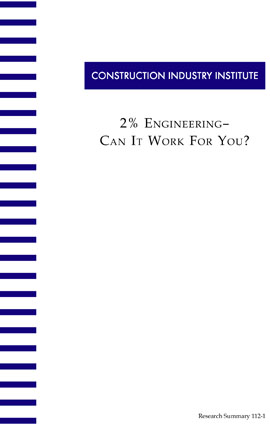
A Framework and Practices for Cost-Effective Engineering in Capital Projects in the A/E/C Industry
A perception within the construction industry, which is reinforced by limited data, holds that current engineering practices are not cost effective. In contrast, some companies such as NUCOR have reported using innovative or non-traditional practices that result in achieving overall business objectives at much lower engineering and capital costs, and with faster schedules, than are normally experienced in the construction industry. CII Research Team 112 was formed to identify, compile, assess, and provide objective information on the context of application, possible benefits, and possible risks associated with such practices, especially those which have a potential to improve the competitiveness of an owner organization.
This research was performed with the following specific objectives:
- Identify innovative or non-traditional practices that have contributed to successful projects in NUCOR and other selected organizations using apparently low cost engineering.
- Evaluate qualitatively each practice and the various potential implications of its use (e.g., risk, schedule, costs, value, content of engineering deliverables, rework, appropriate projects, company culture, and contractual issues).
- Determine various drivers that play a role in determining the use of these practices within an organization.
- Develop an organizational scheme to associate, qualify, and assess these practices, their implications, and their drivers.
The methodology used to achieve the research objectives included the following tasks:
- Identify and select a group of owner organizations (including NUCOR, a selected sample of its design, equipment and construction contractors, and other companies), perceived to be pioneering innovative or non-traditional project implementation practices that have led to successful projects relative to their individual business objectives, particularly those with apparent low engineering costs.
- Identify and describe specific practices within the selected organizations, from global approaches, strategies and mechanisms to competition, partnering/alliances and contracts, to specific project management practices within the different phases of a capital project, both at the corporate and capital project levels.
- Document and analyze, to the extent allowed by each organization studied, the specific context, potential benefits and risks, and implementation requirements on the project or the organization, of each practice identified.
- Report the findings.
This report contains an in-depth analysis of the overall context for cost effective engineering, which provides the background for an integrated framework for cost-effective engineering in capital projects in the A/E/C industry. This analysis includes a general overview of the context for the delivery of a capital project; a discussion of the life cycle phases, stakeholders, and general context for capital projects; a discussion of the various roles that engineering plays, the importance of engineering, and the engineering costs within this process; and an analysis of various external influences and factors on engineering costs. The report also provides an overview of 20 innovative or non-traditional practices for cost-effective engineering identified within the interviews conducted in the twelve companies selected and that agreed to participate in this investigation, and describes in detail 10 specific practices that form the core of Nucor’s approach to capital projects.
An important aspect of this investigation is that nature of the data collected in direct interviews which provided the basis of these findings was primarily qualitative; most quantitative data was treated with the appropriate level of confidentiality established by each organization being studied, or was not available to the research team.
This research concludes:
- Yes, 2% engineering costs can be achieved for standard equipment-intensive projects; and
- No, 2% engineering costs cannot be achieved for custom design process-intensive capital projects, but some reduction of costs may be possible.
The research also highlights that typical engineering cost as a percentage of Total Installed Costs (TIC) has been 5-10% for standard equipment intensive projects and 15-20% for custom design process intensive projects. (RR112-11, p. 121)
The strategies and practices described are embedded within approaches to the context of capital projects, contracting and team building, engineering design and technologies, productivity improvement and lessons learned. (RR112-11, p. 75)


